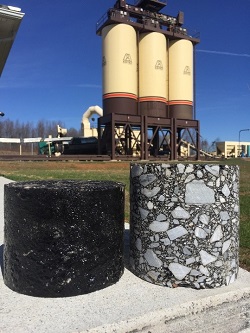Making Pavement Perpetual Using High Modulus High Binder Base
Print this Article | Send to Colleague
For almost two decades, the Asphalt Pavement Alliance has been recognizing pavements that have exhibited long structural life. In fact, Virginia won the award in 2004 for a section of I-81 in Frederick County. With the development for the PerRoad pavement design program by NAPA, many states have designed and constructed perpetual pavements. While not a recognized practice in Virginia, VDOT has been constructing perpetual pavements through the thicknesses and asphalt mixes used on projects.
Recently, VDOT awarded a contract to Wagman Heavy Civil to construct a portion of Odd Fellows Road in Lynchburg. Boxley of Lynchburg was the selected paving contractor for this project. Unlike most construction projects in the state, the district specified a base mix with increased asphalt content specification (also known as BM-25.0 HMHB). Past projects have used this specification, but only the portion where up to 0.4% additional binder was added. On Odd Fellows Road, the Lynchburg District required the 0.8% additional binder – new for a construction project (note: other projects were either maintenance or a pilot project).
 In the mid-2000’s, VDOT developed the BM-25.0 HMHB specification after a research project was completed using intermediate mix (VTRC 07-R15). The base mix is designed at 3.5% air voids and then additional binder is added until the design air voids is reduced to a range between 0.5% and 3.5% and met the other volumetric requirements. Additionally, the mix had a minimum control strip density of 96% of the maximum specific gravity.
In the mid-2000’s, VDOT developed the BM-25.0 HMHB specification after a research project was completed using intermediate mix (VTRC 07-R15). The base mix is designed at 3.5% air voids and then additional binder is added until the design air voids is reduced to a range between 0.5% and 3.5% and met the other volumetric requirements. Additionally, the mix had a minimum control strip density of 96% of the maximum specific gravity. For this project, the total asphalt thickness was 13.5 inches comprised of 1.5" SM-9.5D, 2" IM-19.0D and 10" BM-25.0 HMHB. Boxley designed the HMHB mixture with an AC content of 5.2%, or 0.6% higher than the standard BM-25.0D. The picture to the left shows the gyratory pill and a core of the HMHB mixture. During placement operations, the average in-place density was measured to be 97.1 % of the maximum specific gravity of the mix. Along with the normal lab tests, mixture was sent to the Virginia Transportation Research Council for rut testing. Following the Virginia procedure with the Asphalt Pavement Analyzer, the mix was found to produce an average rut depth of Y. This depth is less than the threshold for surface mixes using a D binder – 5.5 mm.
Time will tell if this pavement is truly perpetual. But starting with a low air void, high modulus, high binder content base mix – future generations should not have to do more than mill and replace the surface on a 15-year cycle. A great savings to VDOT and the traveling public.
